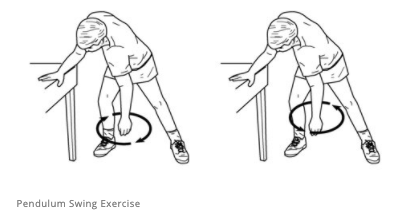Clavicle Surgery Preparation And Recovery Protocol For Athletes
Disclaimer:
The following protocol is what I used based off my doctor’s recommendations and my experience as a strength coach. Your individual needs will vary from mine quite possibly especially if you had additional soft tissue or orthopedic trauma other than the clavicle.
Prior to surgery:
Your primary goal going into surgery is to have your body prepared to handle the procedure and general anesthesia. Here are a few of my tips for getting to your surgery date ready to tackle the road ahead.
Sleep! Your body is healing now and has a lot more to do in the weeks ahead. Sleep 8 hours minimum even if you need to nap. Sleeping on the sofa worked best for me prior to surgery. Post surgery I was able to sleep in the bed supported by extra pillows.
If you are still working you may want to cut back on your hours so you can rest when needed. If you also experienced a TBI (concussion) you should avoid prolonged time on the phone or computer. Your brain needs the rest!
Ice 4 times daily for 15 min, no longer! The soft tissue around the shoulder/ clavicle complex is angry and inflamed. Ice treatment will help decrease inflammation going into surgery. Do not expose the skin to direct cold.
If you have road rash around the shoulder use Xeroform bismuth gauze to heal the skin quickly without the gauze sticking to the wound. You want the skin as healed as possible going into surgery.
Drink a lot of water! Your body is doing it’s best to flush waste materials from the trauma. Water helps! Increase your water intake by 30%
Breathe! Deep cleansing breaths several times throughout the day will promote healing by increasing oxygen uptake. You will also have better pain management and state of mind. If you need help with this try a breathing app like Calm. Breathing deeply will also play a huge role post surgery by cleansing your body of the general anesthesia.
Have button down shirts on hand for ease of clothing changes. Women, get ready to go braless for a bit!
Mobility:
The following exercises can be used prior to surgery and post surgery to improve shoulder, elbow and hand mobility. Perform each mobility exercise prior to surgery and post surgery 4 times daily.
Supported pendulum - The pendulum exercise is a gentle, passive exercise that decreases stiffness in the shoulder and elbow joints. Do this exercise by bending forward at the waist with a straight back. You can hold onto a wall or table with the non-injured arm for support.
Let the injured arm hang down in front of you toward the floor and start to gently make rotations with your hand. Your shoulder should be relaxed and loose. Continue to make arm circles both clockwise and counterclockwise for 30 to 45 seconds each direction. Repeat up to five times with short rests in between as needed.
Pendulum Swing Exercise
Wrist flexion and extension - With fingers curled, bend hand back at the wrist. Bend wrist down with fingers curled. Repeat 10 times.
Shoulder External Rotation
Internal and External Shoulder Rotation - Stand facing a door jam or the corner of a wall. Keep the elbow tight against your side and hold the forearm at a right angle to the arm. For internal rotation, place the palm against the wall with the thumb facing up. For external rotation, place the back of the hand against the wall with the thumb facing up. Pull or push against the wall and hold for 5 seconds.
Wall slide stretch - Stand facing a wall; place the hands of both arms on the wall. Slide the hands and arms upward. As you are able to stretch the hand and arm higher, you should move your body closer to the wall. Hold 10 seconds, lower the arm by pressing the hand into the wall and letting it slide slowly down.
Standing forward flexion - Stand facing a mirror with the hands rotated so that the thumbs face forward. Raise the arm upward keeping the elbow straight. Try to raise the arm by hinging at the shoulder as opposed to raising the arm with the shoulder blade. Do 10 repetitions to 90 degrees. If you can do this without hiking the shoulder blade, do 10 repetitions fully overhead.
Strength:
Week one post surgery as you are ready, perform unilateral upper body exercises with 60-75% normal weight on the non injured arm. Begin attempting the motion of the same exercise unweighted to stimulate neuromuscular control. Week one you will be swollen and tight. You may not feel like attempting much until week 2. Approaching the end of week 1, around the 7 to 10 day point, you may attempt reaching overhead.
Week 2 through 6 - perform unilateral exercises again at 60-75% normal weight with the non injured arm and 5lbs with the injured arm. Your surgeon will clear you to use anything over 5lbs around 6 weeks post surgery.
Overhead press
Unilateral Dumbbell Row
Cable lat pulldown
Cable lat pulldown
Incline chest press
Cable biceps curl
Cable Tricep press
Lateral raise dumbbell
Front raise dumbbell
Lower Body Strength:
Stick to a fairly normal strength routine by using more machines than free weights for squats etc. Some suggestions are - seated leg press, seated hamstring curl, seated calf raise, seated leg extension, standing Bulgarian split squat with body weight, walking lunges.
Cardio:
During the first 4 to 6 weeks you want to assure your stability to prevent any potential falling that may re injure the operative arm. Some suggestions - step mill, seated bike or recumbent bike, walking on a 8-10% incline
Nutrition:
You will not need the same number of calories with reduced activity. Adjust accordingly to your body’s needs. Make sure you are eating quality protein sources and healthy fats to promote healing. Supplementation with extra calcium, magnesium, vitamin K, biotin and collagen will promote bone health and regeneration. Life Extension Bone Restore is great!
Mindfulness:
Be patient and kind to yourself. You will go through ups and downs during healing where you may feel frustrated and grieve the set back to your normal activities. Meditate, spend time in nature and remember, the attention you place on healing will only result in getting back to normal more quickly!














